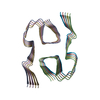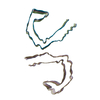登録情報 データベース : EMDB / ID : EMD-40416タイトル Type I beta-amyloid 42 Filaments from Down syndrome 組織 : Type I beta amyloid 42タンパク質・ペプチド : Amyloid-beta protein 42 / / / 機能・相同性 分子機能 ドメイン・相同性 構成要素
/ / / / / / / / / / / / / / / / / / / / / / / / / / / / / / / / / / / / / / / / / / / / / / / / / / / / / / / / / / / / / / / / / / / / / / / / / / / / / / / / / / / / / / / / / / / / / / / / / / / / / / / / / / / / / / / / / / / / / / / / / / / / / / / / / / / / / / / / / / / / / / / / / / / 生物種 Homo sapiens (ヒト)手法 / / 解像度 : 3.17 Å Hoq MR / Bharath SR / Vago FS / Jiang W 資金援助 Organization Grant number 国 National Institutes of Health/National Institute on Aging (NIH/NIA) 5U01NS110437 and and 1RF1AG071177
ジャーナル : Nat Struct Mol Biol / 年 : 2024タイトル : Cryo-EM structures of amyloid-β and tau filaments in Down syndrome.著者: Anllely Fernandez / Md Rejaul Hoq / Grace I Hallinan / Daoyi Li / Sakshibeedu R Bharath / Frank S Vago / Xiaoqi Zhang / Kadir A Ozcan / Kathy L Newell / Holly J Garringer / Wen Jiang / ... 著者 : Anllely Fernandez / Md Rejaul Hoq / Grace I Hallinan / Daoyi Li / Sakshibeedu R Bharath / Frank S Vago / Xiaoqi Zhang / Kadir A Ozcan / Kathy L Newell / Holly J Garringer / Wen Jiang / Bernardino Ghetti / Ruben Vidal / 要旨 : Adult individuals with Down syndrome (DS) develop Alzheimer disease (AD). Whether there is a difference between AD in DS and AD regarding the structure of amyloid-β (Aβ) and tau filaments is ... Adult individuals with Down syndrome (DS) develop Alzheimer disease (AD). Whether there is a difference between AD in DS and AD regarding the structure of amyloid-β (Aβ) and tau filaments is unknown. Here we report the structure of Aβ and tau filaments from two DS brains. We found two Aβ filaments (types IIIa and IIIb) that differ from those previously reported in sporadic AD and two types of Aβ filaments (I and II) identical to those found in sporadic and familial AD. Tau filaments (paired helical filaments and straight filaments) were identical to those in AD, supporting the notion of a common mechanism through which amyloids trigger aggregation of tau. This knowledge is important for understanding AD in DS and assessing whether adults with DS could be included in AD clinical trials. 履歴 登録 2023年4月10日 - ヘッダ(付随情報) 公開 2024年4月3日 - マップ公開 2024年4月3日 - 更新 2024年4月10日 - 現状 2024年4月10日 処理サイト : RCSB / 状態 : 公開
すべて表示 表示を減らす
 データを開く
データを開く 基本情報
基本情報
 マップデータ
マップデータ 試料
試料 キーワード
キーワード Down Syndrome (ダウン症候群) /
Down Syndrome (ダウン症候群) /  NEUROPEPTIDE / Human Trisomy 21
NEUROPEPTIDE / Human Trisomy 21 機能・相同性情報
機能・相同性情報 regulation of Wnt signaling pathway / axo-dendritic transport / synaptic assembly at neuromuscular junction ...regulation of epidermal growth factor-activated receptor activity / signaling receptor activator activity / collateral sprouting in absence of injury / cytosolic mRNA polyadenylation / microglia development / regulation of synapse structure or activity / Formyl peptide receptors bind formyl peptides and many other ligands /
regulation of Wnt signaling pathway / axo-dendritic transport / synaptic assembly at neuromuscular junction ...regulation of epidermal growth factor-activated receptor activity / signaling receptor activator activity / collateral sprouting in absence of injury / cytosolic mRNA polyadenylation / microglia development / regulation of synapse structure or activity / Formyl peptide receptors bind formyl peptides and many other ligands /  regulation of Wnt signaling pathway / axo-dendritic transport / synaptic assembly at neuromuscular junction / smooth endoplasmic reticulum calcium ion homeostasis / axon midline choice point recognition / astrocyte activation involved in immune response / regulation of spontaneous synaptic transmission / mating behavior / NMDA selective glutamate receptor signaling pathway /
regulation of Wnt signaling pathway / axo-dendritic transport / synaptic assembly at neuromuscular junction / smooth endoplasmic reticulum calcium ion homeostasis / axon midline choice point recognition / astrocyte activation involved in immune response / regulation of spontaneous synaptic transmission / mating behavior / NMDA selective glutamate receptor signaling pathway /  繊毛 / Lysosome Vesicle Biogenesis /
繊毛 / Lysosome Vesicle Biogenesis /  PTB domain binding / Golgi-associated vesicle / positive regulation of amyloid fibril formation / neuron remodeling / Insertion of tail-anchored proteins into the endoplasmic reticulum membrane / protein serine/threonine kinase binding / Deregulated CDK5 triggers multiple neurodegenerative pathways in Alzheimer's disease models / : / nuclear envelope lumen / suckling behavior / presynaptic active zone / dendrite development / COPII-coated ER to Golgi transport vesicle / modulation of excitatory postsynaptic potential / TRAF6 mediated NF-kB activation / Advanced glycosylation endproduct receptor signaling / neuromuscular process controlling balance / The NLRP3 inflammasome / regulation of presynapse assembly / transition metal ion binding / regulation of multicellular organism growth / intracellular copper ion homeostasis / negative regulation of long-term synaptic potentiation / negative regulation of neuron differentiation / ECM proteoglycans /
PTB domain binding / Golgi-associated vesicle / positive regulation of amyloid fibril formation / neuron remodeling / Insertion of tail-anchored proteins into the endoplasmic reticulum membrane / protein serine/threonine kinase binding / Deregulated CDK5 triggers multiple neurodegenerative pathways in Alzheimer's disease models / : / nuclear envelope lumen / suckling behavior / presynaptic active zone / dendrite development / COPII-coated ER to Golgi transport vesicle / modulation of excitatory postsynaptic potential / TRAF6 mediated NF-kB activation / Advanced glycosylation endproduct receptor signaling / neuromuscular process controlling balance / The NLRP3 inflammasome / regulation of presynapse assembly / transition metal ion binding / regulation of multicellular organism growth / intracellular copper ion homeostasis / negative regulation of long-term synaptic potentiation / negative regulation of neuron differentiation / ECM proteoglycans /  小胞体 /
小胞体 /  Mitochondrial protein degradation / positive regulation of T cell migration / spindle midzone /
Mitochondrial protein degradation / positive regulation of T cell migration / spindle midzone /  Purinergic signaling in leishmaniasis infection / positive regulation of calcium-mediated signaling / forebrain development /
Purinergic signaling in leishmaniasis infection / positive regulation of calcium-mediated signaling / forebrain development /  クラスリン / regulation of peptidyl-tyrosine phosphorylation / positive regulation of chemokine production /
クラスリン / regulation of peptidyl-tyrosine phosphorylation / positive regulation of chemokine production /  Notchシグナリング / positive regulation of G2/M transition of mitotic cell cycle / neuron projection maintenance / positive regulation of protein metabolic process / ionotropic glutamate receptor signaling pathway / positive regulation of glycolytic process / cholesterol metabolic process / response to interleukin-1 / positive regulation of mitotic cell cycle / extracellular matrix organization /
Notchシグナリング / positive regulation of G2/M transition of mitotic cell cycle / neuron projection maintenance / positive regulation of protein metabolic process / ionotropic glutamate receptor signaling pathway / positive regulation of glycolytic process / cholesterol metabolic process / response to interleukin-1 / positive regulation of mitotic cell cycle / extracellular matrix organization /  軸索誘導 / adult locomotory behavior / trans-Golgi network membrane / dendritic shaft / platelet alpha granule lumen / locomotory behavior / positive regulation of peptidyl-threonine phosphorylation /
軸索誘導 / adult locomotory behavior / trans-Golgi network membrane / dendritic shaft / platelet alpha granule lumen / locomotory behavior / positive regulation of peptidyl-threonine phosphorylation /  学習 / positive regulation of interleukin-1 beta production /
学習 / positive regulation of interleukin-1 beta production /  central nervous system development / positive regulation of long-term synaptic potentiation / endosome lumen / astrocyte activation /
central nervous system development / positive regulation of long-term synaptic potentiation / endosome lumen / astrocyte activation /  Post-translational protein phosphorylation / positive regulation of JNK cascade / synapse organization / regulation of long-term neuronal synaptic plasticity / microglial cell activation / TAK1-dependent IKK and NF-kappa-B activation /
Post-translational protein phosphorylation / positive regulation of JNK cascade / synapse organization / regulation of long-term neuronal synaptic plasticity / microglial cell activation / TAK1-dependent IKK and NF-kappa-B activation /  visual learning / serine-type endopeptidase inhibitor activity /
visual learning / serine-type endopeptidase inhibitor activity /  neuromuscular junction / recycling endosome /
neuromuscular junction / recycling endosome /  認識 / positive regulation of inflammatory response / Golgi lumen / neuron cellular homeostasis /
認識 / positive regulation of inflammatory response / Golgi lumen / neuron cellular homeostasis /  エンドサイトーシス / positive regulation of non-canonical NF-kappaB signal transduction / cellular response to amyloid-beta / positive regulation of interleukin-6 production / Regulation of Insulin-like Growth Factor (IGF) transport and uptake by Insulin-like Growth Factor Binding Proteins (IGFBPs) / neuron projection development / G2/M transition of mitotic cell cycle / positive regulation of tumor necrosis factor production / cell-cell junction /
エンドサイトーシス / positive regulation of non-canonical NF-kappaB signal transduction / cellular response to amyloid-beta / positive regulation of interleukin-6 production / Regulation of Insulin-like Growth Factor (IGF) transport and uptake by Insulin-like Growth Factor Binding Proteins (IGFBPs) / neuron projection development / G2/M transition of mitotic cell cycle / positive regulation of tumor necrosis factor production / cell-cell junction /  シナプス小胞
シナプス小胞
 Homo sapiens (ヒト)
Homo sapiens (ヒト) クライオ電子顕微鏡法 / 解像度: 3.17 Å
クライオ電子顕微鏡法 / 解像度: 3.17 Å  データ登録者
データ登録者 米国, 1件
米国, 1件  引用
引用 ジャーナル: Nat Struct Mol Biol / 年: 2024
ジャーナル: Nat Struct Mol Biol / 年: 2024
 構造の表示
構造の表示 ダウンロードとリンク
ダウンロードとリンク emd_40416.map.gz
emd_40416.map.gz EMDBマップデータ形式
EMDBマップデータ形式 emd-40416-v30.xml
emd-40416-v30.xml emd-40416.xml
emd-40416.xml EMDBヘッダ
EMDBヘッダ emd_40416_fsc.xml
emd_40416_fsc.xml FSCデータファイル
FSCデータファイル emd_40416.png
emd_40416.png emd-40416.cif.gz
emd-40416.cif.gz emd_40416_half_map_1.map.gz
emd_40416_half_map_1.map.gz emd_40416_half_map_2.map.gz
emd_40416_half_map_2.map.gz http://ftp.pdbj.org/pub/emdb/structures/EMD-40416
http://ftp.pdbj.org/pub/emdb/structures/EMD-40416 ftp://ftp.pdbj.org/pub/emdb/structures/EMD-40416
ftp://ftp.pdbj.org/pub/emdb/structures/EMD-40416 リンク
リンク EMDB (EBI/PDBe) /
EMDB (EBI/PDBe) /  EMDataResource
EMDataResource マップ
マップ ダウンロード / ファイル: emd_40416.map.gz / 形式: CCP4 / 大きさ: 589.8 KB / タイプ: IMAGE STORED AS FLOATING POINT NUMBER (4 BYTES)
ダウンロード / ファイル: emd_40416.map.gz / 形式: CCP4 / 大きさ: 589.8 KB / タイプ: IMAGE STORED AS FLOATING POINT NUMBER (4 BYTES) 試料の構成要素
試料の構成要素
 Homo sapiens (ヒト)
Homo sapiens (ヒト)
 Homo sapiens (ヒト)
Homo sapiens (ヒト) アミロイド前駆体タンパク質
アミロイド前駆体タンパク質 クライオ電子顕微鏡法
クライオ電子顕微鏡法 解析
解析 試料調製
試料調製 電子顕微鏡法
電子顕微鏡法 FIELD EMISSION GUN
FIELD EMISSION GUN Bright-field microscopy / Cs: 2.7 mm / 最大 デフォーカス(公称値): 5.0 µm / 最小 デフォーカス(公称値): 0.5 µm / 倍率(公称値): 81000
Bright-field microscopy / Cs: 2.7 mm / 最大 デフォーカス(公称値): 5.0 µm / 最小 デフォーカス(公称値): 0.5 µm / 倍率(公称値): 81000 
 ムービー
ムービー コントローラー
コントローラー




























 Z
Z Y
Y X
X


















